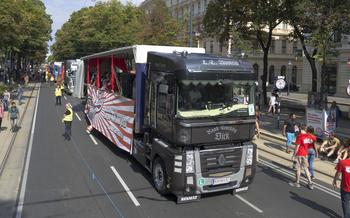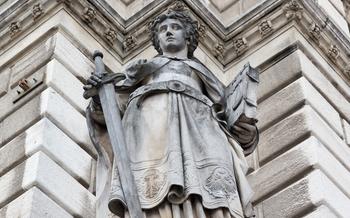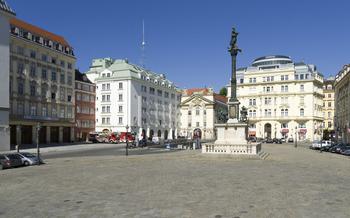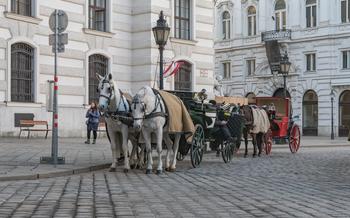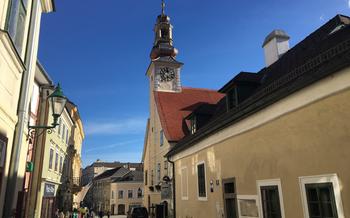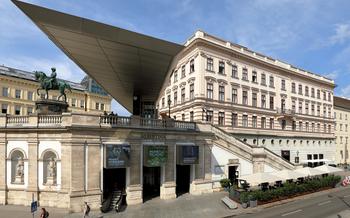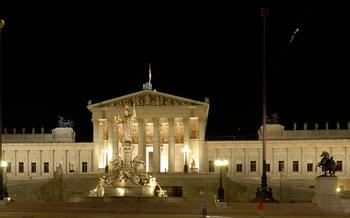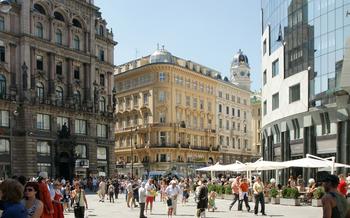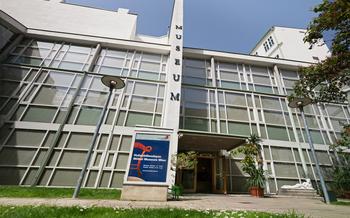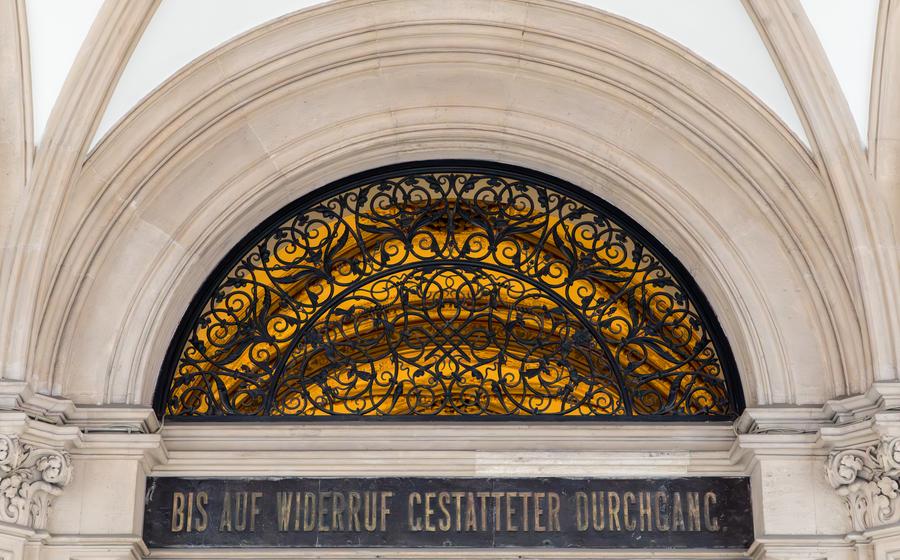
Palais Ferstel
- Palais Ferstel: A Majestic Palace in Vienna's Heart
- Exploring the Grand Façade
- Unveiling the History of Palais Ferstel
- Admiring the Architectural Masterpiece
- A Showcase of Artistic Talent
- Strolling Through the Palais Ferstel Passage
- Indulging in Culinary Delights
- Shopping Haven
- Exploring the Neighborhood
- Practical Information for Visitors
- Palais Ferstel's Legacy
- Insider Tip: Hidden Gem in the Palais
Palais Ferstel: A Majestic Palace in Vienna's Heart
In the vibrant city of Vienna, nestled amidst imperial grandeur and architectural wonders, stands the magnificent Palais Ferstel, a testament to the city's rich history and artistic heritage. This opulent palace, located in the heart of Vienna's bustling Innenstadt district, holds a prominent position among the city's iconic landmarks. As you approach the palace, its grand façade, adorned with intricate details and symbolic sculptures, beckons you to step into a world of elegance and artistry. Palais Ferstel has served various purposes throughout its existence, from a residential and commercial building to a cultural hub hosting exhibitions and events. Today, it remains a vibrant destination, home to luxurious boutiques, historic cafes, and fine dining establishments, inviting visitors to explore its architectural beauty and immerse themselves in its vibrant atmosphere.
Exploring the Grand Façade
The façade of Palais Ferstel is a masterpiece of Neo-Renaissance architecture, adorned with intricate details that captivate the eye. Every inch of the exterior is embellished with ornate carvings, sculptures, and decorative elements, creating a symphony of visual splendor.
The building's most striking feature is the central portico, supported by four massive columns and topped by a grand triangular pediment. The pediment features an allegorical sculpture depicting the triumph of commerce and industry, a fitting symbol for a building designed to be a hub of trade and commerce.
Flanking the portico are two rows of arched windows, each framed by elaborate moldings and crowned by decorative keystones. The windows on the first floor are particularly noteworthy, as they feature intricate wrought-iron balconies that add a touch of elegance to the façade.
The Palais Ferstel is not just a feast for the eyes but also a testament to the skill and artistry of the craftsmen who created it. The building's exterior is a testament to the enduring power of Neo-Renaissance architecture, blending the grandeur of the Italian Renaissance with the elegance of the French Renaissance.
The street-level shops and cafes add a touch of vibrancy to the building's exterior. These establishments, housed in arched openings beneath the grand arcade, invite visitors to step inside and explore the many treasures that the Palais Ferstel has to offer.
Unveiling the History of Palais Ferstel
Commissioned by Baron Albert von Ferstel, a prominent industrialist and patron of the arts, Palais Ferstel was designed by his brother, Heinrich von Ferstel, a renowned architect known for his contributions to the Viennese cityscape. Heinrich Ferstel had already made a name for himself with his design of the Votivkirche, a neo-Gothic church near the University of Vienna.
Construction of Palais Ferstel began in 1856 and was completed in 1860. The palace was originally intended to be a residential and commercial building, reflecting the growing demand for luxury apartments and retail spaces in the heart of Vienna. The Ferstel family occupied the upper floors of the building, while the ground floor and mezzanine were dedicated to shops and offices. Palais Ferstel quickly became a popular destination for the city's elite, who appreciated its elegant design and convenient location.
Admiring the Architectural Masterpiece
The Palais Ferstel is an architectural masterpiece that embodies the essence of the Neo-Renaissance style. Inspired by both Italian and French Renaissance architecture, the building showcases a harmonious blend of classical elements and intricate ornamentation. Its symmetrical façade is adorned with decorative pilasters, ornate moldings, and delicate carvings that add depth and texture to the exterior. The grand entrance, flanked by two majestic columns, invites visitors to step inside and explore the wonders that lie within.
The Neo-Renaissance style, popular during the 19th century, sought to revive the architectural principles and aesthetics of the Italian Renaissance. In the Palais Ferstel, this style is evident in the building's symmetrical composition, the use of classical orders, and the incorporation of decorative elements inspired by Renaissance motifs. The result is a cohesive and visually stunning edifice that pays homage to the grandeur and artistry of the past.
The Palais Ferstel's exterior is a testament to the skill and craftsmanship of the architects and artisans who brought it to life. Its intricate details, such as the sculpted figures adorning the façade, the decorative friezes, and the elaborate cornices, showcase the dedication and precision that went into its construction. The harmonious blend of architectural elements creates a sense of balance and unity that is characteristic of the Neo-Renaissance style.
A Showcase of Artistic Talent
Palais Ferstel boasts an impressive collection of artworks created by renowned artists, transforming the building into a gallery of artistic masterpieces. The ceiling frescoes by Anselm Feuerbach, a prominent German painter, adorn the grand staircase and depict scenes from Greek mythology. These vibrant and intricate murals captivate visitors with their skillful brushwork and mythological symbolism.
The sculptures gracing the building's exterior and interior were crafted by Viktor Tilgner and Carl Kundmann, two esteemed Austrian sculptors. Their works, including allegorical figures, mythical creatures, and portraits, add a touch of grandeur and narrative to the palace's architectural design. The stained glass windows, designed by Eduard Kratzer, a renowned glass artist, bathe the interior spaces in colorful light, creating a mesmerizing and ethereal atmosphere.
This collaboration of talented artists elevates Palais Ferstel beyond its architectural significance, making it a showcase of artistic excellence. Each artwork contributes to the palace's rich cultural heritage and provides visitors with a glimpse into the artistic landscape of 19th-century Vienna.
Strolling Through the Palais Ferstel Passage
Step into the Palais Ferstel Passage, an enchanting covered walkway that runs through the heart of the building. Gaze upon the breathtaking arched glass-covered roof, allowing natural light to flood the passage, creating a luminous and inviting atmosphere. Immerse yourself in the vibrant energy as you explore the array of luxurious boutiques, each showcasing unique and exquisite collections. Embrace the aroma of freshly brewed coffee and delectable pastries wafting from historic cafes, inviting you to savor a moment of indulgence. Whether you seek exclusive fashion, handcrafted souvenirs, or simply a place to unwind, the Palais Ferstel Passage offers an unforgettable shopping and dining experience.
Indulging in Culinary Delights
The Palais Ferstel is home to a remarkable array of dining options, catering to diverse culinary preferences and budgets. Among the most renowned establishments is Cafe Central, a historic Viennese institution celebrated for its elegant ambiance, live piano music, and delectable Viennese cuisine. Indulge in the signature Sachertorte, a rich chocolate cake with a dollop of whipped cream, while soaking in the old-world charm of this iconic cafe.
For a fine dining experience, Restaurant Vestibül offers a contemporary take on Austrian cuisine. Delight in innovative dishes crafted with fresh, seasonal ingredients, accompanied by an exquisite wine selection. The restaurant's elegant interior, with its high ceilings and crystal chandeliers, creates an unforgettable dining atmosphere.
Beyond these two culinary gems, the Palais Ferstel offers a variety of other dining options, ranging from casual cafes to international restaurants. Whether you seek a quick bite, a leisurely lunch, or an intimate dinner, you'll find something to satisfy your taste buds within the palace's walls.
Shopping Haven
Palais Ferstel is not just a historical landmark; it is also a shopping paradise, housing a variety of boutiques and shops that cater to different tastes and budgets. From designer fashion to souvenirs and luxury brands, there is something for everyone within the palace's elegant arcades.
Designer Boutiques: Discerning shoppers will delight in the array of designer boutiques that line the passageway. Here, you can find exclusive collections from renowned fashion houses, ensuring you'll stand out with your unique style.
Souvenir Shops: For those seeking a memento of their visit to Vienna, the Palais Ferstel offers a treasure trove of souvenir shops. Browse through an assortment of postcards, magnets, keychains, and other trinkets that capture the essence of the city.
Luxury Brands: If you're looking to indulge in some retail therapy, the palace is home to several luxury brands, offering exquisite jewelry, watches, handbags, and accessories. Prepare to be tempted by the finest craftsmanship and materials.
Unique Finds: In addition to the established brands, the Palais Ferstel also features unique boutiques that showcase the work of local artisans and designers. Discover one-of-a-kind pieces, including handmade ceramics, intricate glasswork, and stylish textiles.
Exploring the Neighborhood
Palais Ferstel's prime location in Vienna's historic center places it within easy reach of numerous attractions and landmarks. The Hofburg Palace, the former imperial residence of the Habsburg dynasty, is just a short walk away. Visitors can explore its grand halls, museums, and gardens, immersing themselves in the rich history of the Austrian monarchy.
In the vicinity of Palais Ferstel, a wealth of cultural treasures awaits. The Kunsthistorisches Museum and the Naturhistorisches Museum, renowned for their extensive collections of art and natural history, are within walking distance. The Burgtheater, one of the most prestigious theaters in the German-speaking world, is also nearby, offering world-class performances and a glimpse into Vienna's vibrant theater scene.
For those seeking green oases, the Volksgarten and Burggarten, two beautiful parks adjacent to Palais Ferstel, provide a tranquil escape from the bustling city. These parks offer serene strolls, picturesque views, and a chance to relax amidst lush greenery.
To delve deeper into Vienna's history and culture, visitors can embark on guided walking tours that showcase the city's architectural wonders, hidden gems, and intriguing stories. These tours often include a visit to Palais Ferstel, allowing participants to learn about its significance and admire its grandeur from a new perspective.
Practical Information for Visitors
Opening hours and entrance fees:
Palais Ferstel is open to the public daily from 10 am to 8 pm. Entrance to the passage and courtyard is free of charge, allowing visitors to admire the architectural beauty and vibrant atmosphere of this iconic landmark. However, specific exhibitions or events held within the Palais may require separate tickets or reservations.
Accessibility for visitors with disabilities:
Palais Ferstel is committed to ensuring accessibility for all visitors. The passage and courtyard are wheelchair accessible, and elevators provide access to the upper floors for those with limited mobility. Additionally, the Palais offers guided tours that cater to the needs of visitors with disabilities, providing a comprehensive and inclusive experience.
Guided tours availability:
To delve deeper into the history, architecture, and cultural significance of Palais Ferstel, guided tours are available upon request. These tours are led by knowledgeable guides who share fascinating insights and anecdotes about the palace and its illustrious past. Visitors can book guided tours in advance or inquire about availability at the Palais's information desk.
Tips for planning your visit:
- To avoid crowds and fully appreciate the grandeur of Palais Ferstel, consider visiting during off-peak hours, such as early mornings or late afternoons.
- For photography enthusiasts, the best time to capture stunning shots of the palace's exterior and interior is during the golden hours of sunrise and sunset.
- If you're visiting Vienna during the summer months, take advantage of the longer daylight hours to explore the Palais and its surroundings at a leisurely pace.
- Remember to wear comfortable shoes as you'll likely be doing a lot of walking while exploring the passage, courtyard, and the surrounding area.
Palais Ferstel's Legacy
A Landmark in Vienna's Cityscape: Palais Ferstel stands as a testament to architectural excellence and craftsmanship. Its distinct Neo-Renaissance style and ornate façade have made it an iconic landmark in Vienna's cityscape. The palace's grand presence adds to the charm and elegance of the city center, attracting both locals and tourists alike. It has become an integral part of Vienna's urban fabric, a symbol of its rich architectural heritage.
Preservation Efforts and Ongoing Restoration: Recognizing the cultural and historical significance of Palais Ferstel, there have been ongoing efforts to preserve and restore the building. Over the years, the palace has undergone several renovations and restoration projects to maintain its original grandeur. These efforts have ensured that Palais Ferstel continues to shine as a beacon of architectural excellence.
Symbol of Architectural Excellence: Palais Ferstel is a masterpiece of Neo-Renaissance architecture, showcasing the skill and artistry of its designers and builders. The intricate details, symmetrical design, and harmonious blend of Italian and French Renaissance elements make it a prime example of this architectural style. Its enduring beauty and architectural significance have earned it recognition as one of Vienna's finest buildings.
Insider Tip: Hidden Gem in the Palais
Beyond the bustling shops and cafes of the Palais Ferstel Passage, a hidden gem awaits discovery: the serene inner courtyard. This oasis of tranquility, tucked away from the hustle and bustle of the city, offers a unique glimpse into the palace's architectural heritage.
Stepping into the courtyard is like stepping back in time. The elegant arches, intricate carvings, and delicate frescoes transport visitors to a bygone era. The courtyard's centerpiece is a beautiful fountain, surrounded by lush greenery and comfortable seating, creating an inviting space for relaxation and contemplation.
The inner courtyard is a popular spot for locals and tourists alike to escape the crowds and enjoy a moment of peace. It's the perfect place to soak in the beauty of the palace's architecture, read a book, or simply unwind and savor the tranquility of this hidden gem.
So, next time you visit the Palais Ferstel, be sure to venture beyond the passage and explore the hidden courtyard. It's a secret spot that will leave you feeling refreshed, inspired, and with a newfound appreciation for the palace's rich history and architectural beauty.
